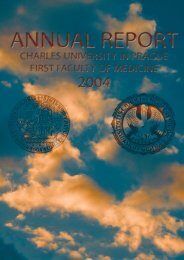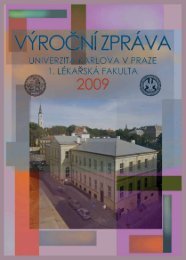zde - 1. lékařská fakulta - Univerzita Karlova
zde - 1. lékařská fakulta - Univerzita Karlova
zde - 1. lékařská fakulta - Univerzita Karlova
You also want an ePaper? Increase the reach of your titles
YUMPU automatically turns print PDFs into web optimized ePapers that Google loves.
36<br />
SEKCE POSTGRADUÁLNÍ – KLINICKÁ ČÁST I<br />
Metodika: Do studie bylo zařazeno 25 obézních žen a 14 štíhlých zdravých žen, u kterých byly provedeny krevní odběry<br />
a odběr subkutánní a viscerální tukové tkáně v průběhu plánovaného chirurgického výkonu (bandáž žaludku resp. cholecystektomie).<br />
Sérové koncentrace inzulinu a cytoadhezivních molekul byly stanoveny multiplexovou imunoanalýzou pomocí Luminex<br />
kitů, exprese mRNA CAM ve vzorcích tukové tkáně metodou real-time PCR a proteinová exprese CAM pomocí Luminex<br />
kitů a normalizována k obsahu proteinů.<br />
Výsledky: U obézních žen jsme zaznamenali signifikantně vyšší BMI a solubilních CAM E-selectinu a ICAM-<strong>1.</strong> Sérové koncentrace<br />
VCAM-1 se mezi skupinami významně nelišily. Nebyl zaznamenán rozdíl v expresích mRNA a proteinů CAM v subkutánním<br />
tuku mezi skupinou obézních a štíhlých žen. Naopak, ve viscerálním tuku byla exprese mRNA i proteinová exprese pro<br />
ICAM-1 a VCAM-1 významně zvýšená ve skupině obézních žen (ICAM-1 kontroly vs. obézní (BMI 30-40): 6,4 x 10 -5 ± 2 x 10 -5 vs.<br />
1,99 x 10 -4 ± 3,7 x 10 -5 , p < 0,01; VCAM-1 kontroly vs. obézní (BMI 30-40): 6,2 x 10 -5 ± 2 x 10 -5 vs. 2 x 10 -4 ± 6,3 x 10 -5 , p < 0,5).<br />
Závěr: Výsledky svědčí pro zvýšenou produkci proaterogenně působících cytoadhezivních molekul ve viscerální tukové<br />
tkáni obézních žen, ne však v subkutánní tukové tkáni. Výsledky studie tak mohou částečně objasnit vztah mezi rizikem kardiovaskulárních<br />
onemocnění a akumulací viscerálního tuku u obézních jedinců popsaný zejména ve velkých epidemiologických<br />
studiích.<br />
Podporováno IGA 8302-5 a MZO 000064165.<br />
UNRUPTURED INTRACRANIAL ANEURYSMS – CLIP, COIL OR NATURAL COURSE OF DISEASE?<br />
A LONG TERM, PROSPECTIVE, SINGLE INSTITUTIONAL STUDY<br />
1 2 1,3 1 Authors: Bradáč Ondřej, M.D., Beneš Vladimír III., M.D., Beneš Vladimír II., M.D., PhD., Department of<br />
Neurosurgery, Central military hospital in Prague, Charles University in Prague, First Faculty of Medicine,<br />
2Department of Neurosurgery, Regional Hospital Liberec<br />
Supervisor: prof. Vladimír Beneš, DrSc., 1Department of Neurosurgery of the First Faculty of Medicine and Central<br />
Military Hospital in Prague<br />
Objective: Management of unruptured intracranial aneurysms is still a frequently discussed topic. We aim to predict optimal<br />
age for changing the treatment from active to passive therapy and to determine differences between surgical and endovascular<br />
procedures. These predictions are based on the data from our prospectively collected database during the period 1990 -<br />
2006.<br />
Methods: 321 unruptured aneurysms of anterior circulation were included in our study, divided into two groups – surgical<br />
and endovascular (156 and 165 UIAs). Life expectancies of the patients posing UIA of certain diameter in various ages were<br />
determined from annual rupture rates. These life expectancies were compared with the life expectancy after an active treatment<br />
procedure with certain procedural risk derived from our database.<br />
Results: The overall procedural mortality and morbidity was 5.8% in the surgical and 4.2% in the endovascular group. Zero<br />
benefit ages were determined for small (age of 50 for surgery, age of 36 for endovascular techniques), medium (age of 68 and<br />
59), large (age of 63 for surgery) and giant (age of 70 for surgery) aneurysms. The years saved by active therapy in comparison<br />
with the watch and wait strategy for the patient at the age of 20 were determined as 1, 7, 27 and 42 years for small, medium,<br />
large and giant UIAs, similar by both modalities.<br />
Conclusions: The benefit of active treatment was proven for medium, large and giant unruptured intracranial aneurysms till<br />
great age. In case of small aneurysms one should decide entirely on individual basis.<br />
CARBOHYDRATE-DEFICIENT TRANSFERRIN HAS HIGHER SENSITIVITY AND SPECIFICITY FOR THE<br />
DETECTION OF ALCOHOL ABUSE THAN GMT, AST/ALT RATIO AND MCV IN THE CIRRHOTIC POPU-<br />
LATION<br />
Authors: Dousa Miroslav, Zima Tomas, Mejstrikova Ester, Bruha Radan<br />
Supervisor: doc. MUDr. Radan Brůha, CSc., IV. interní klinika <strong>1.</strong> LF a VFN<br />
In the cirrhotic patients correct knowledge about alcohol abuse is of great importance. In this study we analyzed the contribution<br />
of the percentage of carboxy deficient transferrin (%CDT) to diagnose alcohol abuse in the cirrhotics. Sensitivity and specificity<br />
of %CDT was compared with conventional markers (GMT, AST/ALT ratio, mean erythrocytes corpuscular volume MCV).<br />
Methods: Patients (n=45) with liver cirrhosis (ethylic aetiology) were examined for laboratory markers of alcohol abuse and<br />
average daily alcohol intake in the 28 days previous to the laboratory examination (calculated according to standardised self<br />
reported protocol). %CDT was assessed using Axis-Shield assay.<br />
Results: In the cirrhotics the higher level of %CDT was the most significant marker of alcohol abuse (Mann-Whitney,<br />
p=0.0002). Higher MCV (Mann-Whitney, p=0.0015) was also significant. On the other hand, GMT and AST/ALT ratio were not<br />
found to be significant. Sensitivity of %CDT (cut off 2.8) in estimation of alcohol abuse was 79%, sensitivity of MCV was (cut off<br />
96 fL) 76%. Specificity of %CDT (cut off 2.8) in the estimation of alcohol abuse was 92% and specificity of MCV (cut off 96 fL) was<br />
67%.






